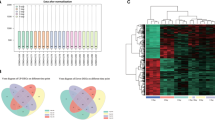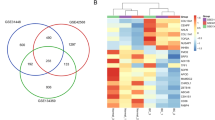Abstract
The contributing molecular pathways underlying the pathogenesis of breast cancer need to be better characterized. The principle of our study was to better understand the genetic mechanism of oncogenesis for human breast cancer and to discover new possible tumor markers for use in clinical practice. We used complimentary DNA (cDNA) microarrays to compare gene expression profiles of treated Michigan Cancer Foundation-7 (MCF-7) with recombinant bromelain and untreated MCF-7. SpringGene analysis was carried out of differential expression followed by Ingenuity Pathway Analysis (IPA), to understand the underlying consequence in developing disease and disorders. We identified 1,102 known genes differentially expressed to a significant degree (p < 0.001) changed between the treatment. Within this gene set, 20 genes were significantly changed between treated cells and the control cells with cutoff fold change of more than 1.5. These genes are RNA-binding motif, single-stranded interacting protein 1 (RBMS1), ribosomal protein L29 (RPL29), glutathione S-transferase mu 2 (GSTM2), C15orf32, Akt3, B cell translocation gene 1 (BTG1), C6orf62, C7orf60, kinesin-associated protein 3 (KIFAP3), FBXO11, AT-rich interactive domain 4A (ARID4A), COPS2, TBPL1|SLC2A12, TMEM59, SNORD46, glioma tumor suppressor candidate region gene 2 (GLTSCR2), and LRRFIP. Our observation on gene expression indicated that recombinant bromelain produces a unique signature affecting different pathways, specific for each congener. The microarray results give a molecular mechanistic insight and functional effects, following recombinant bromelain treatment. The extent of changes in genes is related to and involved significantly in gap junction signaling, amyloid processing, cell cycle regulation by BTG family proteins, and breast cancer regulation by stathmin1 that play major roles.









Similar content being viewed by others
References
Chobotova, K., Vernallis, A. B., & Majid, F. A. A. (2010). Bromelain’s activity and potential as an anti-cancer agent: current evidence and perspectives. Cancer Letters, 290(2), 148–156.
Berit, B., & Tysnes, H. R. M. (2001). Torsten Porwol, Beatrice Probst, Rolf Bjerkvig, Frank Hoover, Bromelain reversibly inhibits invasive properties of glioma cells. Neoplasia, 3(6), 469–479.
Rajendra, P., Jain, S., Shraddha, A., Ajay, K. (2012). Properties and therapeutic application of bromelain: a review. Biotechnology Research International. 2012 (2012) (Article ID 976203): p. 6
Amid, A., et al. (2011). Expression, purification, and characterization of a recombinant stem bromelain from Ananas comosus. Process Biochemistry, 46(12), 2232–2239.
Paul, C. (2004). Protein purification protocols. Totowa: Human press.
Lucia, F., & Tomas, G. V. (2010). Native and biotechnologically engineered plant proteases with industrial applications. Journal Food Bioprocess Technology, 4, 1066–1088.
Muntari, B., et al. (2011). Recovery of recombinant bromelain from Escherichia coli BL21-AI. African Journal of Biotechnology, 10(81), 18829–18832.
Dang, C., et al. (2003). Cytokinetics. In D. W. Kufe, R. E. Pollock, & R. R. Weichselbaum (Eds.), Holland-Frei cancer medicine (6th ed.). Hamilton: BC Decker.
Clarke, P. A., te Poele, R., & Workman, P. (2004). Gene expression microarray technologies in the development of new therapeutic agents. European Journal of Cancer, 40(17), 2560–2591.
Bala, M., et al. (2011). Recovery of recombinant bromelain from Escherichia coli BL21-AI. African Journal of Biotechnology, 10(81), 18829–18832.
Zar, J. H. (1999). Biostatistical analysis (4th ed.). New Jersey: Prentice Hall.
Ghosh, S., et al. (2011). Global gene expression and ingenuity biological functions analysis on PCBs 153 and 138 induced human PBMC in vitro reveals differential mode(s) of action in developing toxicities. Environment International, 37(5), 838–857.
Dutta, S. K., et al. (2012). Differential gene expression and a functional analysis of PCB-exposed children: understanding disease and disorder development. Environment International, 40, 143–154.
Erk, M. J., et al. (2005). Integrated assessment by multiple gene expression analysis of quercetin bioactivity on anticancer-related mechanisms in colon cancer cells in vitro. European Journal of Nutrition, 44(3), 143–156.
Lin, Y.-H., et al. (2007). Multiple gene expression classifiers from different array platforms predict poor prognosis of colorectal cancer. Clinical Cancer Research, 13(2), 498–507.
Nakamura, T., et al. (2004). Genome-wide cDNA microarray analysis of gene expression profiles in pancreatic cancers using populations of tumor cells and normal ductal epithelial cells selected for purity by laser microdissection. Oncogene, 23(13), 2385–2400.
Hurst, D. R., et al. (2008). Alterations of BRMS1-ARID4A interaction modify gene expression but still suppress metastasis in human breast cancer cells. Journal of Biological Chemistry, 283(12), 7438–7444.
Duisters, R. F., et al. (2009). miR-133 and miR-30 regulate connective tissue growth factor: implications for a role of MicroRNAs in myocardial matrix remodeling. Circulation Research, 104(2), 170–178.
Yu, F., et al. (2010). Mir-30 reduction maintains self-renewal and inhibits apoptosis in breast tumor-initiating cells. Oncogene, 29(29), 4194–4204.
Mao-De, L., & Jing, X. (2007). Ribosomal proteins and colorectal cancer. Current Genomics, 8(1), 43–49.
Zhou, S.-G., et al. (2008). Reduced expression of GSTM2 and increased oxidative stress in spontaneously hypertensive rat. Molecular and Cellular Biochemistry, 309(1–2), 99–107.
Kennedy, N. J., Cellurale, C., & Davis, R. J. (2007). A radical role for p38 MAPK in tumor initiation. Cancer Cell, 11(2), 101–103.
Denti, S., et al. (2006). The COP9 signalosome regulates Skp2 levels and proliferation of human cells. Journal of Biological Chemistry, 281(43), 32188–32196.
Kalt, I., et al. (2010). GLTSCR2/PICT-1, a putative tumor suppressor gene product, induces the nucleolar targeting of the Kaposi’s sarcoma-associated herpesvirus KS-Bcl-2 protein. Journal of Virology, 84(6), 2935–2945.
Wu, M.-Y., Eldin, K. W., & Beaudet, A. L. (2008). Identification of chromatin remodeling genes Arid4a and Arid4b as Leukemia suppressor genes. Journal of the National Cancer Institute, 100(17), 1247–1259.
Hirokawa, N., & Noda, Y. (2008). Intracellular transport and kinesin superfamily proteins, KIFs: structure, function, and dynamics. Physiological Reviews, 88(3), 1089–1118.
Daire, V., & Poüs, C. (2011). Kinesins and protein kinases: key players in the regulation of microtubule dynamics and organization. Archives of Biochemistry and Biophysics, 510(2), 83–92.
Bruno, L., Salierno, M., Wetzler, D. E., Despósito, M. A., & Levi, V. (2011). Mechanical properties of organelles driven by microtubule-dependent molecular motors in living cells. PLoS One, 6(4), e18332.
Haraguchi, K., et al. (2006). Role of the kinesin-2 family protein, KIF3, during mitosis. Journal of Biological Chemistry, 281(7), 4094–4099.
Park, J. J., Cawley, N. X., & Loh, Y. P. (2008). Carboxypeptidase E cytoplasmic tail-driven vesicle transport is key for activity-dependent secretion of peptide hormones. Molecular Endocrinology, 22(4), 989–1005.
Deepthi, T., Jagadeesha, M., Harsh, P., Arivusudar, M., Manoj Kumar, K., Ramachandra, Y. L., et al. (2012). overexpression of kinesin associated protein 3 (KIFAP3) in breast cancer. Journal Proteomics Bioinformatics, 5, 122–126.
Blomme, E. A. G., Yang, Y., & Waring, J. F. (2009). Use of toxicogenomics to understand mechanisms of drug-induced hepatotoxicity during drug discovery and development. Toxicology Letters, 186(1), 22–31.
Saverio, B., et al. (2000). Tumor progression is accompanied by significant changes in the levels of expression of polyamine metabolism regulatory genes and clusterin (sulfated glycoprotein 2) in human prostate cancer specimens. Cancer Research, 60(1), 28–34.
Frasor, J., et al. (2003). Profiling of estrogen up- and down-regulated gene expression in human breast cancer cells: insights into gene networks and pathways underlying estrogenic control of proliferation and cell phenotype. Endocrinology, 144(10), 4562–4574.
Rouault, J., et al. (1996). Identification of BTG2, an antiproliferative p53-dependent component of the DNA damage cellular response pathway. Nature Genetics, 14, 482–486.
Cho, I. J., et al. (2005). Repression by oxidative stress of iNOS and cytokine gene induction in macrophages results from AP-1 and NF-κB inhibition mediated by B cell translocation gene-1 activation. Free Radical Biology and Medicine, 39(11), 1523–1536.
Hamatani, T., et al. (2004). Global gene expression analysis identifies molecular pathways distinguishing blastocyst dormancy and activation. Proceedings of the National Academy of Sciences of the United States of America, 101(28), 10326–10331.
Dean, J. L., et al. (2010). Therapeutic CDK4/6 inhibition in breast cancer: key mechanisms of response and failure. Oncogene, 29(28), 4018–4032.
Nevins, J. R. (2001). The Rb/E2F pathway and cancer. Human Molecular Genetics, 10(7), 699–703.
Whitfield, M. L., et al. (2002). Identification of genes periodically expressed in the human cell cycle and their expression in tumors. Molecular Biology of the Cell, 13(6), 1977–2000.
Malumbres, M., & Barbacid, M. (2009). Cell cycle, CDKs and cancer: a changing paradigm. Nature Reviews Cancer, 9, 153–166.
Kelsell, D. P., Dunlop, J., & Hodgins, M. B. (2001). Human diseases: clues to cracking the connexin code? Trends in Cell Biology, 11(1), 2–6.
Hofer, A., & Dermietzel, R. (1998). Visualization and functional blocking of gap junction hemichannels (connexons) with antibodies against external loop domains in astrocytes. Glia, 24(1), 141–154.
Brachmann, S. M., et al. (2009). Specific apoptosis induction by the dual PI3K/mTor inhibitor NVP-BEZ235 in HER2 amplified and PIK3CA mutant breast cancer cells. Proceedings of the National Academy of Sciences, 106(52), 22299–22304.
Kamenetz, F., et al. (2003). APP processing and synaptic function. Neuron, 37(6), 925–937.
Hansel, D. E., et al. (2003). Increased expression and processing of the Alzheimer amyloid precursor protein in pancreatic cancer may influence cellular proliferation. Cancer Research, 63(21), 7032–7037.
Kayed, R., et al. (2003). Common structure of soluble amyloid oligomers implies common mechanism of pathogenesis. Science, 300(5618), 486–489.
Wang, K. K. W., & Po-Wai, Y. (1994). Calpain inhibition: an overview of its therapeutic potential. Trends in Pharmacological Sciences, 15(11), 412–419.
Song, G., Ouyang, G., & Bao, S. (2005). The activation of Akt/PKB signaling pathway and cell survival. Journal of Cellular and Molecular Medicine, 9(1), 59–71.
DeFeo-Jones, D., et al. (2005). Tumor cell sensitization to apoptotic stimuli by selective inhibition of specific Akt/PKB family members. Molecular Cancer Therapeutics, 4(2), 271–279.
Vivanco, I., & Sawyers, C. L. (2002). The phosphatidylinositol 3-kinase-AKT pathway in human cancer. Nature Reviews Cancer, 2, 489–501.
Rana, S., et al. (2008). Stathmin 1: a novel therapeutic target for anticancer activity. Expert Review of Anticancer Therapy, 8(9), 1461–1470.
Karst, A. M., et al. (2011). Stathmin 1, a marker of PI3K pathway activation and regulator of microtubule dynamics, is expressed in early pelvic serous carcinomas. Gynecologic Oncology, 123(1), 5–12.
Dejda, A., et al. (2010). Involvement of stathmin 1 in the neurotrophic effects of PACAP in PC12 cells. Journal of Neurochemistry, 114(5), 1498–1510.
Raftopoulou, M., & Hall, A. (2004). Cell migration: Rho GTPases lead the way. Developmental Biology, 265(1), 23–32.
Barillé-Nion, S., et al. (2012). Regulation of cancer cell survival by BCL2 family members upon prolonged mitotic arrest: opportunities for anticancer therapy. Anticancer Research, 32(10), 4225–4233.
Brichese, L., Cazettes, G., & Valette, A. (2004). JNK is associated with Bcl-2 and PP1 in mitochondria: paclitaxel induces its activation and its association with the phosphorylated form of Bcl-2. Cell Cycle, 3(10), 1312–1319.
Koo, C.-Y., Muir, K. W., & Lam, E. W. F. (2012). FOXM1: from cancer initiation to progression and treatment. Biochimica et Biophysica Acta (BBA)-Gene Regulatory Mechanisms, 1819(1), 28–37.
Kovács, K. J. (1998). Invited review c-Fos as a transcription factor: a stressful (re)view from a functional map. Neurochemistry International, 33(4), 287–297.
Karadedou, C. T. (2006). Regulation of the FOXM1 transcription factor by the estrogen receptor α at the protein level, in breast cancer. Hippokratia, 10(3), 128–132.
Ingman, W. V., & Robertson, S. A. (2008). Mammary gland development in transforming growth factor beta1 null mutant mice: systemic and epithelial effects. Biology of Reproduction, 79(4), 711–717.
Cox, D., Penney, K., Guo, Q., Hankinson, S. E., & Hunter, D. J. (2007). TGFB1 and TGFBR1 polymorphisms and breast cancer risk in the Nurses' Health Study. BMC Cancer, 7, 175.
Acknowledgments
The authors gratefully acknowledge the support from the International Islamic University Malaysia for providing research grant number EDW B11-078-0556 and the Institute of Medical Research (IMR), Kuala Lumpur, for letting the researchers use the GeneSpring software in conducting this research.
Author information
Authors and Affiliations
Corresponding author
Rights and permissions
About this article
Cite this article
Fouz, N., Amid, A. & Hashim, Y.Z.HY. Gene Expression Analysis in MCF-7 Breast Cancer Cells Treated with Recombinant Bromelain. Appl Biochem Biotechnol 173, 1618–1639 (2014). https://doi.org/10.1007/s12010-014-0947-6
Received:
Accepted:
Published:
Issue Date:
DOI: https://doi.org/10.1007/s12010-014-0947-6




